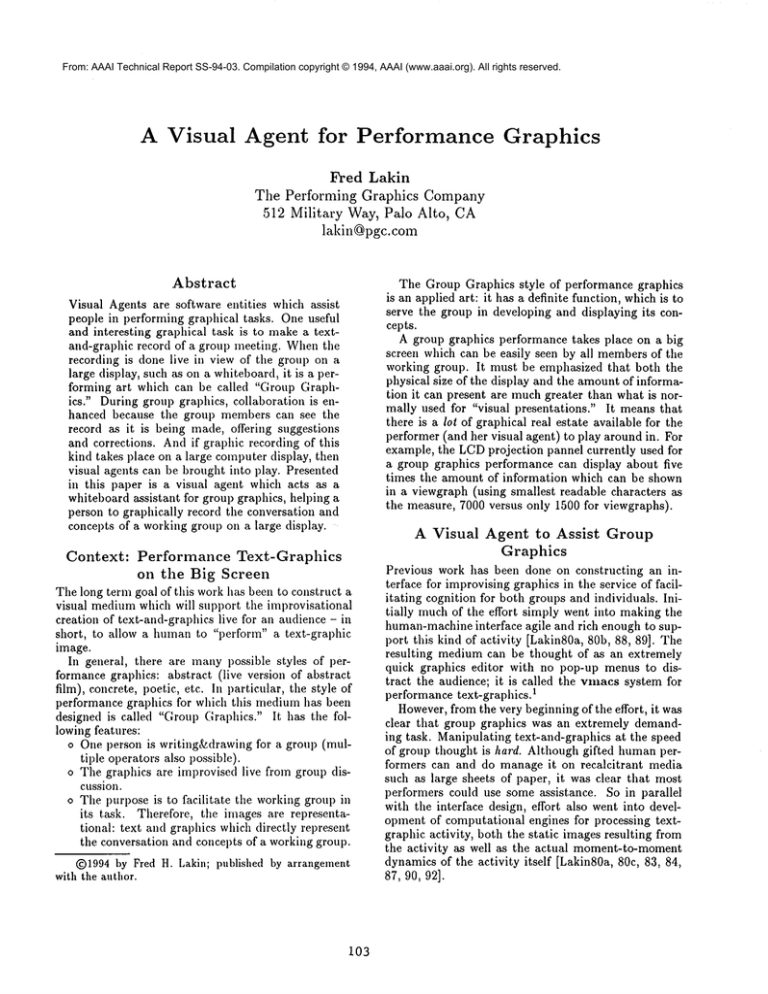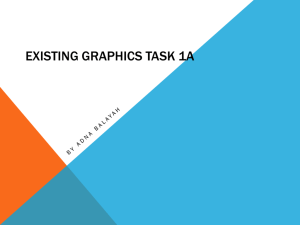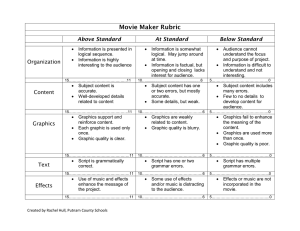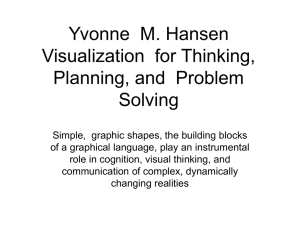
From: AAAI Technical Report SS-94-03. Compilation copyright © 1994, AAAI (www.aaai.org). All rights reserved.
A Visual
Agent for Performance
Graphics
Fred Lakin
The Performing
Graphics
Company
512 Military
Way, Palo Alto, CA
lakin@pgc.com
Abstract
The Group Graphics style of performance graphics
is an applied art: it has a definite function, whichis to
serve the group in developing and displaying its concepts.
A group graphics performance takes place on a big
screen which can be easily seen by all membersof the
working group. It nmst be emphasized that both the
physical size of the display and the amountof information it can present are muchgreater than what is normally used for "visual presentations." It means that
there is a lot of graphical real estate available for the
performer (and her visual agent) to play around in. For
example, the LCDprojection pannel currently used for
a group graphics performance can display about five
times the amount of information which can be shown
in a viewgraph (using smallest readable characters as
the measure, 7000 versus only 1500 for viewgraphs).
Visual Agents are software entities which assist
people in performing graphical tasks. One useful
and interesting graphical task is to make a textand-graphic record of a group meeting. Whenthe
recording is done live ill view of the group on a
large display, such as on a whiteboard, it is a performing art which can be called "Group Graphics." During group graphics, collaboration is enhanced because the group members can see the
record as it is being made, offering suggestions
and corrections. And if graphic recording of this
kind takes place on a large computer display, then
visual agents can be brought into play. Presented
in this paper is a visual agent which acts as a
whiteboard assistant for group graphics, helping a
person to graphically record the conversation and
concepts of a working group on a large display.
A Visual
Performance
Text-Graphics
on the Big Screen
The long term goal of this work has been to construct a
visual mediumwhich will support the improvisational
creation of text-and-graphics live for an audience - in
short, to allow a human to "perform" a text-graphic
image.
In general, there are many possible styles of performance graphics: abstract (live version of abstract
film), concrete, poetic, etc. In particular, the style of
performance graphics for which this mediumhas been
designed is called "Group Graphics." It has the following features:
o One person is writing&drawing for a group (multiple operators also possible).
o The graphics are improvised live froln group disContext:
cussion.
o The purpose is to facilitate the working group in
its task. Therefore, the images are representationah text and graphics which directly represent
the conversation and concepts of a working group.
@1994by Fred H. Lakin; published by arrangement
with the author.
103
Agent to Assist
Group
Graphics
Previous work has been done on constructing an interface for improvising graphics in the service of facilitating cognition for both groups and individuals. Initially muchof the effort simply went into making the
human-machineinterface agile and rich enough to support this kind of activity [Lakin80a, 80b, 88, 89]. The
resulting medium can be thought of as an extremely
quick graphics editor with no pop-up menus to distract the audience; it is called the wnacs system for
1performance text-graphics.
However,from the very beginning of the effort, it was
clear that group graphics was an extremely demanding task. Manipulating text-and-graphics at the speed
of group thought is hard. Although gifted humanperformers can and do manage it on recalcitrant
media
such as large sheets of paper, it was clear that most
performers could use some assistance. So in parallel
with the interface design, effort also went into development of computational engines for processing textgraphic activity, both the static images resulting from
the activity as well as the actual moment-to-moment
dynamicsof the activity itself [Lakin80a, 80c, 83, 84,
87, 90, 92].
This processing of text-graphic activity is the underlying technology which perrnits the fimctioning of visual agents. The basic idea is that, first, the visual media system’s interface permits the performer to generate spatial-temporal patterns which are in fact the performance. This is just a way of saying that text-andgraphics are moving around on the screen over time.
Andthen, second, because this performance takes place
in a mediumwhich has an underlying computational
model, those same spatial-temporal
patterns can be
processed immediately by the system as they occur.
This processing allows software modules- visual agents
- to recognize certain visual patterns and assist the
humanin the task of creating/lnanipulating those patterns.
The result is that the system is dynamically processing the performance for the purpose of helping the
human do the performance. This permits a style of
human-machineinteraction called Graphic Dialog.
Graphic Dialog with a Visual Agent
In the graphic dialog situation, the humanis generating text-and-graphics, and the visual agent is watching
what the humanis doing. The visual agents’s role can
be fairly passive, just measuring aspects of the performance, or more agressive, actually intervening in the
human’s manipulation of text-and-graphics, in a sense
becominga co,.operator of the display..
¯
"
huma~~
....2.............. ,00°=
OaJeCTWES
ow~Sm
eVaLUATION
visual
agent
n
w
II
(~
Figure 1. Visual Agents in Vlllacs have-complete
access to user actions and the state of the visual
world in the midst of text-gral)hic performance.
Simply put, a graphic dialog occurs when two entities are trading text-graphics back and forth, entityOne creates some text-and-graphics, and, by l)utting
them on the screen, sublnits them to entityTwo, who
looks at the text-and-graphics, and then returns some
text-and-graphics which entityOne looks at, and so oil
and so forth. Ill this case, one entity is the humanand
the other is a visual agent.
Whena visual agent is assisting group graphics,
the human generates text-and-graphics
representing
the group’s cognition, and the agent intervenes on the
display from time to time. For ease of reference, the visual agent for group graphics has been nalned "Dave."
WhenDave goes into action, he appears on the screen
as an eye (for seeing) and an arm with hand (for
nipulating). Dave’s intervention is triggered when the
humancreates certain visual patterns in the course of
group graphics.
Patterns Dave currently recognizes include arrangements involving lists of textual items with hand-drawn
bullets; pieces of text connected to any text-graphic object by a hand-drawn straight arrow; two text-graphic
objects connected by straight lines (figure 2); and
hand-drawn hollow arrows, with text inside and at the
tail end, pointing to any text-graphic object.
v bdol Ilaah uh*n ~roup,~g
v ma~augg~l~ona
(IOOdam
m~y]
v ~n~m
grapha~
on o~ion
vrec~grdzea
pa~e~m:
bullelhsl.
hok~w
arm~,
al ~owa,
mnn
li~s
You
HAVE
THAt
howwo
kn~BHOWN
Oov*
Jo
m,r*
IS
CONNEOTEO
TO
BOTH
lext,0rlphl¢
dlIJog
b.o~
;ex~.gl~icI mla~ ~th*
fop~e~m
ma
~oe
g~a~ic
pedo
mance
,
"~ visu~~..rnl
’KtNO’
OFCONNEGTION$
...
COULO
YOU
LABEL
THE
TWO
CONNECTIN~I
UN|$
YO
|HOW
THE
OIFFERENCE9
Figure 2. Dave’s response when the user draws two
connecting lines.
These patterns are used in a visual language developed for group facilitation by a talented graphical
performer [Sibbet80]. Whenthe human creates a pattern which is recognized, Dave then generates a textgraphic response and this object is displayed on the
screen. The response is appropriate both to the general type of visual pattern which triggered it, and to
specific elements in each individual triggering pattern
(if part of the triggering pattern is an element that
Dave cannot deal with, such as an arbitrary cartoon,
then that element is simply copied directly into the response using a template based generation technique).
Visual
Agent Architecture
At this point in the developmentof visual agents, it is
felt that a relatively simple mechanismreacting appropriately to complex humanactivity in a rich graphic
envirolnent is a useful first step. Whenthat behavior
has been acheived, then it will be relatively easy to add
sophistication to agent responses using standard technologies (see Future Work). vlnacs provides a basic
framework for visual agent implementation:
o Each user action is represented symbolically.
o Agents can examine each user action before and
after execution.
o Agents can examine state of visual world before
and after each user action.
o Agents can change state of visual world before
and after each user action.
o Agents can use mechanisms based on visual
parsing and logic programming.
o Agents can communicate with other agents
through a visual blackboard which accepts
multi-media postings (visual as well as symbolic
objects, figure 4).
104
vm~lmad’b~0te"aal~n
.~l e ........
Visual
Parser
: r~ion :
,
Implementation
of Dave the Visual Agent
The underlying framework of the wnacs system supports humansin text-graphic performance, and also allows agents as performance administrators to observe
each atomic user action committed by the human and
its effect on the visual world (figure 3). WhenDave
is running, the Controller uses a simple model of the
visual activity of group graphics in conjunction with
on-the-fly Visual Parsing which watches for patterns
signaling intervention situations.
:: ~The .visual parsing is grammar-driven, utilizing a
visually notated context-free grammar[Lakin87]. This
allows Dave to recognize objects like hollow arrows,
bullet lists, etc. In order to control Dave’s pattern
recognition behavior, one simply writes&draws the visual rules that he uses in recognizing when he should
intervene.
[
Controller
~ ~-k Stream of user
I-----~-~
~1 I~ text-graphic
ba~,~o, i~a~pol=~ly
m~c~fi*d
............J.....
’ ~ a=,o.s
PARSE.FAILEO,
h~
~=uafwodd
~e¢a~km
Figure 3. Visual Agent architecture showing relation between Controller and Visual Parser.
At this time 8 different visual agents have been implemented:
o Dave tile group graphics assistant.
o A Fitt’s Lawdaemon to group drawn lines dur2ing sketching.
o A logic-based activity characterizer for conceptual design drawing.
o A logic-based pointing trainer (cursor control).
o A marking trainer (drawing skills).
o A visual language trainer for aphasics.
o A "graphic speedometer" which measures textgraphic manipulations per second.
o An agent which maintains spatial connectivity
between straight arrows and their objects.
More than one agent can run at the same time,
jointly administrating
the same performance. The
order in which agents have access to user actions
can be specified. 7 of the 8 agents have been run
simultaneously, z Agents communicate with each other
through the multi-media blackboard; image parsing allows agents to extract symbolic and visual information
from the postiugs.
’81BTRAN-GRAMMAR"
::.
"siblran.expt*--~
"hokato-pat"
%ibltan.expt"
-~) *bullet,oat"
"wblran.expr"
-~) *=l-ato*pal"
"sibtran-expr"
~ lexllinep
%~uan.expr’
"~ ~/
"~o~alo.par ~
texllinep
@
"61.aro-p&l"~ IoXl~nop
"bullel’lisl" ~ wt extlmli~o
*buBel-li="
"louaet-I~="
.-----) 9 text~nop
Figure 5. Machine-readable Visual Grammar Notation for the context-free grammar used by Dave
in parsing user generated text-graphic patterns.
Features of Dave’s implementation:
o Easy to Control: behavior is specified by visual
rules (visual grammardriven).
o Permissive: user can write&draw whatever she
wants; when Dave happens to see a pattern he
recognizes, then he intervenes.
o Non-Exclusive:
Dave can co-operate
with
other agents which may be administrating the
same performance (for instance, the "graphic
speedometer" agent); all agents communicate
through the visual blackboard.
o Extensible: pixmap images and animations are
available to the performer now; in the future
the visual grammarwill be extended to include
those types of user actions.
//f~
BAD-WORDS
(’damn’)
oill 0 ln l
SPURIOUS-IMPLICATIONS?
(("blues"
TOP-FIVE-TG-MIPS
TOP-TG-MIPS
ACTIVITY-ANALYSIS
> ¯ "siolyaN.expf"
*buNet.pat*
-m~t extlinllp
~ullel.hsl"
Agents’
Blackboard
UNRECOGNIZED-GRAPHICS
. "~bltan-e~r"
-> "rock"))
(92.0 45.6 43.0 19.0 10.0)
Related
Work
Maes and Kozierok have described an intelligent agent
which employs machine learning to assist humans in
the tasks of meeting scheduling and sorting electronic
mail [Maes93]. Like the work presented here, that
agent performs in real-time; but the time window is
weeks or months, not just the current user session.
Also, their agent operates only in a text-based domain.
(MRS::LEVEL-OF-DETAIL
0.6)
ACTIVITY-METER
¢1~
Figure 4. Visual Agents in wnacs corumunicate
with each other through multi-media postings to a
visual blackboard.
105
Lieberman describes all agent which helps the user
with graphical layout tasks [Lieberman93]; his "Mondrian" system does programming by example in a visual domain. Like the work presented here, his system does spatial parsing. However, the parsing ill
Mondrian is not accomplished using context-free visual
grammars. Another difference is that vmacs agents do
not use programming by example.
Current
Status
Footnotes
A live Group Graphics performance was given at SGI
in March of 1993 [Lakin93a] using a super VGALCD
projection pannel (1024x768) on an 8x6 foot screen.
Dave the visual agent made his functional debut in a
live demo at IBM’s USERworkshop in June of 1993
[Lakin93b].
Performing graphics live on a big screen (via LCD
projection pannel) is the presentation format of choice
for this research. If the work is selected for the symposium, I hope to have the opportunity to do a live
performance.
The vmacs system with the visual agent architecture is implemented using CommonLisp and X windows; it currently runs on a Sun Sparcstation or any
other platform running CL and CLX. A Windows NT
port is underway.
Future
ful suggestions in preparing the first public demoof
Dave for Ted’s USER(New Paradigms In Compuiing)
WORKSHOP
at IBM Almaden in June 1993. And to
the hardy few whograciously suffered being rehearsed
at and then offered invaluable feedback: Jeff Aldrich,
Peter Broadwell, David Brown, Tony Chang, Ron Fischer, Becky Fuson, WadeHennessey, Scott Kim, Henry
Lieberman, Rob Myers, and Greg Nuyens.
Work
The Performing Graphics Companywas formed for the
purpose of giving live computer graphic performances.
At the momentperformances are service oriented: facilitative graphics for working groups. Wehope in the
future to branch out into entertainment oriented performances as well. It is intended that Daveparticipate
more fully in both situations.
In the system described here, we claim that responsiveness, usability and verisimilitude for visual agents
can arise out of a relatively sirnple mechanismreacting appropriately to coml)lex humanactivity in a rich
graphic enviroment. Agent behavior is currently determined by a Controller which uses a very sparse procedural model of Group Graphics. Nowthat the system can function in real-time to administrate live performaaces, construction of more sophisticated control
regimes is underway. Workon a logic based descriptive model of Group Graphics has been started. When
finished, the logic model will plug into the Controller
in place of the procedural one, providing more varied
4and finely grained responses to user graphic activity.
Weare also considering a Controller design utilizing
machine learning techniques like those described in
[Maes93]; such a Controller would use data from visual parsing to build and continually update a spatial
performance profile for the user.
1 "vmacs"and "PerformingGraphics"are trademarksof
The Performing Graphics Company.
2 Implemented
to support design research of DavidM.
Cannon
at
Stanford.
3 Themarkingtrainer preemptscontrol of the interface
in a waythat cooperationwith other agentsis not possbile.
4 TheControllersfor several of the other visual agents
already employlogic programming,
including the pointing
trainer andthe designcharacterizer.
References
[Lakin80a] Lakin, Fred, "A Structure from Manipulation
for Text-GraphicObjects", published in the proceedings of
SIGGRAPH
80, Seattle, Washington, July, 1980.
Lakln80b] Lakin, Fred, "Diagrammingon the Electric
ackboard," video tape, SIGGRAPH
80, July 1980.
Lakin83] Lakin, Fred, "Measuring Text-Graphic Activty", published in the proceedings of GRAPHICS
INTERFACE83, Edmonton, Alberta, May 1983.
Lakin84] Lakin, Fred, "Visual CommunicationExpert",
ublic Broadcast television
segment on COMPUTER
CHRONICLES
KCSM,as part of show on Artificial
Intelligence, March22, 1984.
[Lakln87] Lakin, Fred, "Visual Grammarsfor Visual Languages," published in the proceedings of conference of the
AMERICAN ASSOCfor A RTIFICIA L INTELLIGENCE,
Seattle, Washington,July 12-17, 1987, pp 683-688.
[Lakin88] Lakin, Fred, "A Performing Medium for
Working Group Graphics,"
chapter in COMPUTER.
SUPPORTEDCOOPERATIVEWORK, edited by Greif,
Irene, MorganKaufmanPublishers, Palo Alto, 1988.
[Lakin92] Lakin, F, V Baya, D Cannon, MBrereton, L
Leifer and G Toye, "MappingDesign Information," paper
for the AAAI 92 Workshop on Design Rationale Capture
and Use, San Jose, CA, July 1992.
[Lakin93a] ,,[,akin,
Fred, "WORKING
GROUPDISPLAY
... revisited,’ 45 minute text-graphic piece performed at
Silicon Graphics in MountainView, CA, March25, 1993.
[
!
D
[GLakin93b]
"A Visual
AgentUSER:
for Group
raphics," Lakin,
talk Fred,
and demo
at the
NEW
PARADIGMS FOR USING COMPUTERS Workshop,
IBMAhnadenresearch lab, June 15, 1993.
[Lieberman93] Lieberman, Henry, "Mondrian: a Teachable Graphic Editor. In: A. Cypher ed. WATCHWHAT
I DO: PROGRAMMINGBY DEMONSTRATION. Cambridge, Mass.: MITPress. Forthcoming.
[Maes93] Maes, Pattie and Kozierok, Robyn, "Learning
Interface Agents," published in the proceedingsof the conference of the AMERICANASSOCfor ARTIFICIAL INTELLIGENCE,1993.
[SibbetS0]
Sibbet, David, A WORKSHOP
GUIDETO
THE GRAPHIC FACILITATION OF GROUPS, The
Grove Consultants, San Francisco, CA, 1980.
Acknowledgements
To Ted Selker for encouraging me in resuming investigation of the visual agent theme, and for manyuse-
106






